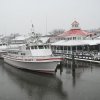As a science teacher, I heed the facts, the truth. I accept the truth that the world is warming, that climate change is real, that the heap of climate change evidence, agreed on by over 2,000 of the world’s leading climatologists, reveals the ultimate, defining challenge. Climate-induced extreme weather becomes even more common and severe. Ask those in western North Carolina where water and sewer lines rebuilt to resist 1,000-year floods were totally destroyed by Hurricane Helene. Early evidence suggests that heat domes contribute to the recent regional decline of our beloved ospreys.
The need to respond is real and urgent; take a few minutes to watch Robert Krulwich’s “Engine Trouble” or National Geographic’s “Before the Flood” or read any number of authoritative and informative books to get a better sense of the challenge and the needed response.
Renewable energy keeps our air and water cleaner by producing little or no CO2 and other greenhouse gases and pollutants, costs much less than any fossil fuel, and lacks the challenges of nuclear energy.
What’s proposed by US Wind will provide much-needed energy (saving ratepayers at least $500 million), needed jobs (thousands in Maryland and Delaware; the wind project is endorsed by the International Brotherhood of Electrical Workers) and more money ($591 million, much of it to address needed infrastructure) to Delawareans. Furthermore, at miles offshore, a turbine will appear only enough to invite curiosity and tourism much like our one turbine at the University of Delaware.
Science, the truth, has revealed absolutely no significant harm to animals and plants, to the natural environment whether at 3R’s Beach or anywhere around the wind turbines or their connections; at Pennsylvania’s Hawk Mountain Sanctuary, turbines on nearby ridges have little to no effect on the thousands of raptors and other birds that migrate through in the fall and spring, and, given the habitat destruction from fossil fuel burning, local birders and bird conservation groups enthusiastically endorse wind energy.
Let’s do our best to help, such as by supporting clean and renewable energy, by conserving energy through adjusting our thermostats or recycling more and better, or traveling the speed limit in efficient cars, and by walking and biking more, all while appreciating our beautiful and wondrous and life-sustaining natural world, one alive with our admirable ospreys and their kin; they and our children deserve nothing less.























































